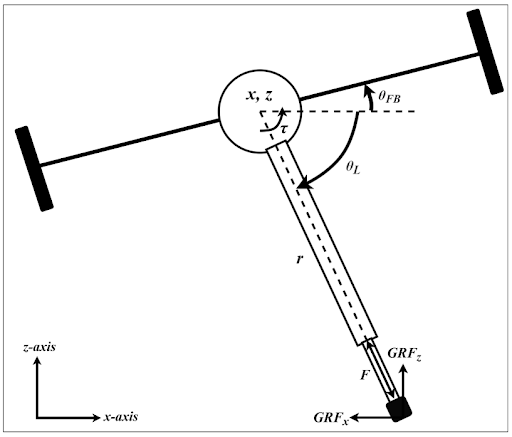Legged robots have advantages over other forms of terrestrial locomotion, such as wheeled or treaded locomotion. In the past, legged locomotion on compliant terrains, such as sand or gravel, has been a primary challenge in robotics. The difference in dynamics due to the interaction between the foot and the ground makes it increasingly difficult to design controllers that successfully execute on multiple surfaces. However, to achieve true autonomy, robots must be able to handle complex and rough terrain generally found outside of the lab.

In recent years, legged robotics has become the focal point, aided by developments in trajectory optimisation methods. Under the supervision of Dr Callen Fisher of the Department of Electrical and Electronic Engineering at Stellenbosch University, master’s student, Jacques Meyer, investigated trajectory optimisation methods for a pneumatically actuated mono-pod on rigid and compliant terrain. This research is a continuation of the work done in the PhD of Dr Fisher.
Research method
Trajectory optimisation was utilised to obtain trajectories for acceleration, steady-state and deceleration hopping on compliant terrain and rigid terrain surfaces. For the compliant terrain trajectories, a novel method was developed to model the specific characteristics of the compliant terrain. Trajectories were generated using this method for two compliant terrain types: rough gravel and fine gravel.
A simplified mathematical model was furthermore developed to (i) mimic the pneumatic actuation in the trajectory optimisation problem and (ii) accommodate the bang-bang force of the pneumatic actuator. This model used complementarity constraints and node bucketing techniques to mimic the behaviour of a real pneumatic actuator with damping and delay.
Once these methods and models were implemented, trajectories were executed in an open loop on a fixed-body robotic platform designed and built for this research. Finally, the executions were compared to the trajectory results.
Research results
The rigid terrain trajectories successfully executed on a hard surface but failed on gravel surfaces. The compliant terrain trajectories executed successfully on gravel surfaces, indicating that the method developed to model compliant terrain is a more accurate representation of the gravel surfaces compared to the rigid terrain trajectories. After these results showed that the methods used to describe the compliant terrain proved accurate, a free-body mono-pod robot and support rig was designed and built. The support rig limited the movement of the mono-pod to the sagittal plane to mimic the limitations of the trajectory optimisation model. Acceleration, steady-state and deceleration trajectories were generated for the free-body mono-pod on compliant and rigid terrain surfaces.
From these trajectories, a controller was designed with the primary feedback sources being the robot’s height and the angle of the free-moving body of the robot. The free-body mono-pod robot used the controller to execute hopping from rest back to rest with three steady-state hops in between. For each terrain type, the controller was adjusted based on the generated trajectories. The results show successful execution of the trajectories on all terrain types using the controller.
Lastly, multi-surface hopping was executed on the mono-pod robot platform. The controller was adjusted to hop from a hard surface to a compliant surface and executed these trajectories successfully.

Recommended future research
Recommended future work includes expanding this technique to bipeds and quadrupeds. Using sensory feedback to obtain terrain properties and adjust the controller accordingly can be looked at.
This will allow dynamic switching from one gait to another without a predefined state machine. Finally, implementing the hybrid method to describe compliant terrain can be tested on more terrain types to confirm its viability.
Below is a link to a video showing the robot executing all the different trajectories on the different surfaces:
Download and read the full research: Meyer, J. (2022). Trajectory Optimization Inspired Pneumatic Locomotion on Compliant Terrains. https://scholar.sun.ac.za/handle/10019.1/124602





